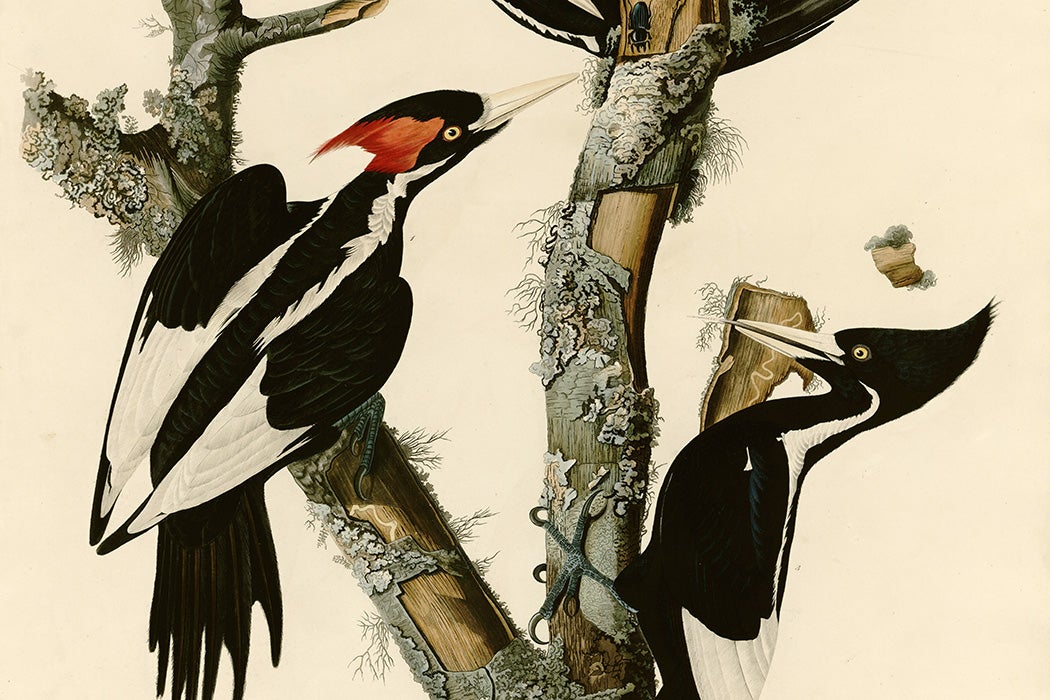Eight decades without definitive evidence is a long time. As a new study brings attention to the case of the Ivory-billed Woodpecker once again, we might ask ourselves, “Is it even possible that a species found in the hardwood bottomlands of the southeast, already described by William Faulkner as a ‘doomed wilderness’ eighty years ago, still exists?”
The last universally accepted evidence of this big, boldly patterned woodpecker’s existence came in the early 1940s. The species has been presumed absent from the United States for more than half a century, with a subspecies hanging on in Cuba (where the last confirmed sighting was in 1986). Ivory-billed Woodpeckers had the misfortune of falling afoul of humans: logging, hunting, development, and monocultures of cotton, rice, and catfish—a series of habitat-devastating plantation economies.
Sightings have been reported over the decades, but eyewitnesses, contrary to the fantasies of courtroom dramas, are often less than reliable. Hard proof, like clear photos, unambiguous recordings, active nest holes, and/or bodies, was lacking.
Then, in 2005, media erupted with an announcement that the bird had been rediscovered in Arkansas. The evidence, gathered over the previous year, including a four-second video of a bird in flight.
Ornithologist Jerome A. Jackson, appointed to the US Fish and Wildlife Service’s Advisory Committee on evaluating the status of the Ivory-billed Woodpecker in 1986 and on the same agency’s later Ivory-billed Woodpecker Recovery Team, wrote:
“The news galvanized ornithologists, birders, conservationists—indeed, the world. At a time rife with news of war and natural disasters, this good news inspired hope in life’s resilience.”
Hope, after all, as Emily Dickinson wrote, “is the thing with feathers.” But the grainy photographic evidence didn’t convince everybody that this thing with feathers was the bird in question. Some, like Jackson, thought the video showed a Pileated Woodpecker, another large woodpecker found in the region.
So the search continued. The Cornell Lab, one of the sponsors of the 2004 study, continued looking for the bird between 2006 and 2010. Their verdict on this second search: “no definitive evidence of a surviving Ivory-billed Woodpecker population was found.”
Cut to late 2021, when the US Fish and Wildlife Service proposed that the Ivory-billed Woodpecker be removed from the endangered species list and officially declared extinct in the US. The proposal has met with some resistance. For instance, Tim Gallagher, one of the co-authors of the 2005 paper, detailed his own 2004 sighting in a published argument against the de-listing.
The latest paper, which hasn’t been peer-reviewed, is the result of a decade-long study. The authors argue that they have trail cam and drone video evidence suggesting “the consistent presence of Ivory-billed Woodpeckers” at their study site in Louisiana. Others trumpeted this news with less caution than “suggesting” suggests.
But the continuing lack of definitive pictures leaves this latest case for the Ivory-billed’s existence open to skepticism.
Jackson’s review of the situation after the 2005 announcement is a good introduction to the story from an insider’s perspective. One of his Advisory Committee partners was James Tanner, an ornithologist who had done so much work on the species in the 1930s that he was still known as the “godfather” of Ivory-billed Woodpeckers a half century later.
Jackson details how he learned from Tanner that the mouthpieces of clarinets and saxophones can be used to imitate the call of the Ivory-billed. And that knuckles on wood can give a good imitation of the bird’s rapping-on-tree-trunks sound.
Weekly Newsletter
There may have been unintended consequences of the 2005 hype. Jackson notes that $10.2 million was pledged by the federal government for Ivory-billed recovery efforts after the alleged sighting. But this represented a re-allocation of money budgeted for projects to study and conserve other endangered species. These projects suddenly found themselves defunded.
This caveat of Jackson’s holds true as the status of this spectacular woodpecker continues to arouse passionate responses: “Scientific truth is not decided by a consensus of public opinion, but by the quality of data presented and rigorous independent review of those data.”







